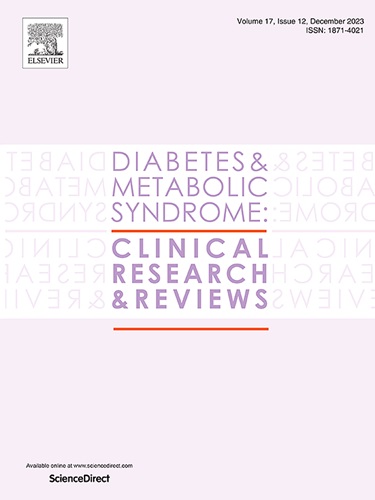食物环境、绿色空间和步行性在社会经济地位与2型糖尿病之间的中介作用——马斯特里赫特研究
IF 3.4
Q1 ENDOCRINOLOGY & METABOLISM
Diabetes & Metabolic Syndrome-Clinical Research & Reviews
Pub Date : 2024-11-01
DOI:10.1016/j.dsx.2024.103155
引用次数: 0
摘要
目的:探讨社会经济地位(SEP)、居住饮食环境、步行性、绿地与2型糖尿病(T2D)之间的相互作用,特别是环境因素是否在SEP与T2D之间起到中介作用。方法:对9188名调查对象进行SEP、T2D状况、居住食品环境健康指数(FEHI)、快餐店数量(FF)、步行指数(WI)和绿地比例(GS)的测定。采用logistic回归和生存分析对SEP、环境和T2D之间的关系进行建模。通过因果中介分析估计SEP与T2D之间关联的中介比例。结果:低SEP与高T2D风险相关。教育、收入和职业四分位数范围下降(IQR)的风险比分别为2.03 (95% CI 1.60-2.58)、1.79(1.40-2.30)和1.77(1.21-2.58)。环境因子IQR变化的hr分别为:FEHI 1.20(1.00 ~ 1.43)、FF 0.87(0.76 ~ 0.99)、WI 1.23(0.95 ~ 1.58)、GS 1.16(0.96 ~ 1.43)。对流行T2D的回归也得到了类似的结果。较低的社会经济地位与较不健康的环境相关(例如,教育FEHI为-0.10(-0.12—0.07))。环境暴露介导了0.1%(-0.7-0.9)至2.6%(0.4-5.2)的横断面关联和0.3%(-8.6-8.6)至8.5%(2.3-27.4)的纵向关联。结论:低SEP人群患T2D的风险和患病率较高,居住环境健康程度稍差。SEP和T2D之间的关联不受FEHI、FF、WI或GS的强烈介导。本文章由计算机程序翻译,如有差异,请以英文原文为准。
The mediating role of the food environment, greenspace, and walkability in the association between socioeconomic position and type 2 diabetes — The Maastricht Study
Aims
This study investigates the interplay between socioeconomic position (SEP), the residential food environment, walkability, greenspace, and type 2 diabetes (T2D), particularly whether the environmental factors mediate the association between SEP and T2D.
Methods
SEP, T2D status, residential Food Environment Healthiness Index (FEHI), number of fast-food outlets (FF), walkability index (WI), and proportion of greenspace (GS) were ascertained in 9188 participants. The associations between SEP, the environment and T2D were modeled with logistic regression and survival analysis. The proportion of mediation of the association between SEP and T2D was estimated with causal mediation analysis.
Results
Lower SEP was associated with higher risk of T2D. Hazard ratios (HR) were 2.03 (95 % CI 1.60–2.58), 1.79 (1.40–2.30) and 1.77 (1.21–2.58) for an interquartile range decrease (IQR) of education, income, and occupation, respectively. HRs for IQR changes of the environmental factors were: FEHI 1.20 (1.00–1.43), FF 0.87 (0.76–0.99), WI 1.23 (0.95–1.58) and GS 1.16 (0.96–1.43). Regression on prevalent T2D yielded similar results. Lower socioeconomic position was associated with a less healthy environment (e.g., FEHI −0.10 (−0.12–−0.07) for education). Environmental exposures mediated between 0.1 % (−0.7–0.9) and 2.6 % (0.4–5.2) of the cross-sectional associations and 0.3 % (−8.6–8.6) and 8.5 % (2.3–27.4) of the longitudinal associations.
Conclusions
People with lower SEP had higher risk and prevalence of T2D and lived in a slightly less healthy residential environment. The association between SEP and T2D is not strongly mediated by FEHI, FF, WI, or GS.
求助全文
通过发布文献求助,成功后即可免费获取论文全文。
去求助
来源期刊

Diabetes & Metabolic Syndrome-Clinical Research & Reviews
ENDOCRINOLOGY & METABOLISM-
CiteScore
22.90
自引率
2.00%
发文量
248
审稿时长
51 days
期刊介绍:
Diabetes and Metabolic Syndrome: Clinical Research and Reviews is the official journal of DiabetesIndia. It aims to provide a global platform for healthcare professionals, diabetes educators, and other stakeholders to submit their research on diabetes care.
Types of Publications:
Diabetes and Metabolic Syndrome: Clinical Research and Reviews publishes peer-reviewed original articles, reviews, short communications, case reports, letters to the Editor, and expert comments. Reviews and mini-reviews are particularly welcomed for areas within endocrinology undergoing rapid changes.
 求助内容:
求助内容: 应助结果提醒方式:
应助结果提醒方式:


